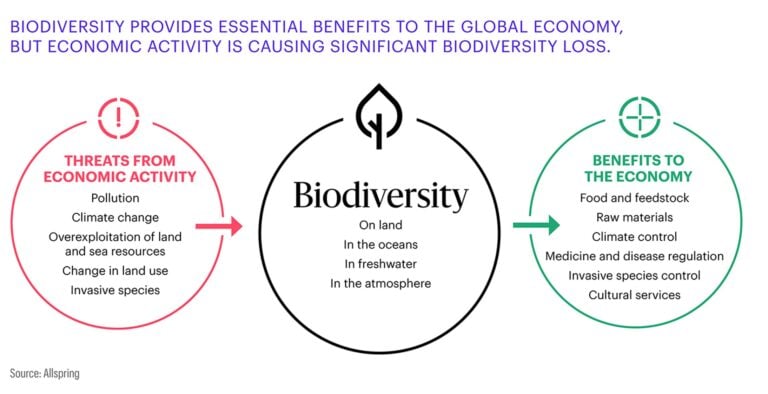What Biodiversity Loss Could Mean for the Global Economy
In Allspring’s new series, “Eye on SI,” we present perspectives on sustainable investing (SI) and discuss how various environmental and social themes can create investment risks and opportunities.

Key takeaways
- Biodiversity benefits the global economy, but economic activity is causing significant biodiversity loss.
- Improvements in ways to measure biodiversity loss would make it easier to invest in biodiversity.
- Recognition of biodiversity’s importance to humanity and the climate is growing, as evidenced by a new initiative: the Taskforce on Nature-related Financial Disclosures.
What do the golden toad, paradise parrot, Little Swan Island hutia, and Yarkon bleak all have in common? They’re 4 of 19 animal species identified as extinct in 2011 primarily due to climate change and severe weather.[1] Between 1950 and 2021, the world also lost 50% of its living coral.[2]
The term biodiversity (short for biological diversity) encompasses the entire variety of living things—from the very largest plants and animals down to tiny microorganisms that can’t be seen with the naked eye. Beyond the sadness many likely feel when they hear about the decline or extinction of a rising number of animal and plant species, it’s important to recognize the meaningful impact biodiversity loss could have on the planet and global economy—and thereby on investors’ portfolios.

According to the World Economic Forum, over 50% of global gross domestic product in 2019—$44 trillion of economic value generation—may be at risk from biodiversity loss.[3] Sectors such as forestry, agriculture, fisheries, food and beverage, and electricity generation are at highest risk due to their reliance on natural capital.[4]
For example, pollination, which plays a crucial role in maintaining the world’s agricultural food production system, is harmed by biodiversity loss. It’s estimated that up to $600 billion of annual global food production relies on pollination from honeybees, native bees, and flies.[5] As another example, a broad variety of plant and animal species are used by the pharmaceuticals industry to produce treatments for a range of conditions and diseases, including cancer. Their extinction would negatively affect this multibillion-dollar industry and pose real threats to human health.[6]
Reverting biodiversity loss would help mitigate climate change
At the same time that climate change is contributing to the planet’s loss of biodiversity, deforestation and land development are releasing massive amounts of carbon—the leading cause of climate change—into the atmosphere. It’s estimated that 12% to 20% of total global greenhouse gas (GHG) emissions are attributable to changes in land use.[7]
Unlike emissions from industrial manufacturing and transportation, the negative impacts of emissions linked to biodiversity loss are multiplied. That’s because natural, undeveloped land areas can serve as a carbon sink, absorbing GHGs from the atmosphere and limiting climate-related effects. The Environmental Protection Agency estimated that carbon absorption by managed forests and other undeveloped land offset 12% of U.S. emissions in 2021.[8] It seems clear that embracing the role biodiversity can play in mitigating climate change (rather than ignoring it) would likely make this battle much easier to win.
Understanding and measuring the scope of negative impacts on biodiversity can provide valuable forward-looking insights. Measuring the degrees of deforestation and/or reforestation, for example, would help governments and investors track progress toward established climate targets.
Investing in biodiversity would be easier with useful methods for measuring its positive impacts
Considering the facts noted earlier, you might expect that biodiversity management is one of the main levers used in fighting climate change. However, Earth loses 5 million hectares of forest each year,[9] which makes established climate objectives more challenging to achieve.
According to the Paulson Institute, $124 billion to $143 billion was spent globally on biodiversity conservation in 2019, with 80% to 85% coming from the public sector.[10] In contrast, the International Energy Agency expects the global investment in clean energy to reach $1.7 trillion in 2023.[11]
When it comes to financial instruments, the picture is similar. Out of about 12,000 corporate and sovereign sustainable fixed income instruments available on Bloomberg.com, more than 9,200 are financing renewable energy projects while only 2,300 include agriculture, forestry, or biodiversity as possible uses of proceeds.[12]
What can explain the big gap in assets allocated toward climate-related versus biodiversity-related projects? For one thing, it’s much harder to measure changes in biodiversity and even more difficult to assess the impacts of that change on financial performance. In terms of financial analyses of climate risks, investors are further ahead—thanks to a developed global regulatory environment, independent reporting standards, and industry initiatives such as the Task Force on Climate-Related Financial Disclosures. These days, investors understand the differences between scopes of GHG emissions and know the magnitude of change can be measured in degrees of Celsius or Fahrenheit.
Another challenge in measuring biodiversity is the lack of standardized, company-specific metrics. Impacts on biodiversity are typically measured at the macro level—for example, acres of forest coverage or species count. This makes it difficult to analyze idiosyncratic risk and impact, especially when investors want wide data coverage for their investable universe.
A nature-related framework has emerged
Thankfully, recognition of biodiversity’s importance to humanity and the climate is growing among investors and regulators alike. One of the most meaningful efforts was the announcement of a new initiative, the Taskforce on Nature-related Financial Disclosures (TNFD), in July 2020. After three years of deliberation since then by a group of companies, scientific organizations, standard-setting bodies, and investors, TNFD has published 14 recommendations on how to integrate nature-related issues into decision-making, risk management, and disclosures. TNFD’s main objective is to promote the provision of clear, comparable, and consistent information by companies to investors and other providers of capital.
At Allspring, we welcome the TNFD framework and believe it will yield decision-useful information for integrating biodiversity-related risks into investment analyses, portfolio construction, and new-product development. We’ll continue communicating about TNFD as well as other related risks, opportunities, and market developments that investors should find beneficial.
In Allspring’s new series, “Eye on SI,” we present perspectives on sustainable investing (SI) and discuss how various environmental and social themes can create investment risks and opportunities.
[1]. Javier Monzón, Lucas Moyer-Horner, and Maria Baron Palamar, “Climate Change and Species Range Dynamics in Protected Areas,” BioScience, October 2011 / Vol. 61 No. 10, https://academic.oup.com/bioscience/article/61/10/752/258069
[2]. Tyler D. Eddy, Vicky W.Y. Lam, Gabriel Reygondeau, John F. Bruno, Yoshitaka Ota, William W.L. Cheung, “Global decline in capacity of coral reefs to provide ecosystem services,” Global decline in capacity of coral reefs to provide ecosystem services, https://www.cell.com/one-earth/fulltext/S2590-3322(21)00474-7#%20
[3]. WEF_The_Future_Of_Nature_And_Business_2020.pdf (weforum.org)
[4]. “ESG The Long View. Biodiversity: Meet the New Climate”, JP Morgan report, Figure 9, page 13
[5]. The Value Of Pollinators To The Ecosystem And Our Economy (forbes.com)
[6]. https://www.goldmansachs.com/intelligence/pages/gs-research/assessing-the-financial-links-to-natural-capital/report.pdf
[7]. CFF5-2019-ENG-DIGITAL.pdf (climatefundsupdate.org)
[8]. Sources of Greenhouse Gas Emissions | US EPA
[9]. Deforestation and Forest Loss – Our World in Data
[10]. https://www.paulsoninstitute.org/conservation/financing-nature-report/
[11]. Clean energy investment is extending its lead over fossil fuels, boosted by energy security strengths – News – IEA
[12]. Allspring analysis
CFA® and Chartered Financial Analyst® are trademarks owned by CFA Institute.


